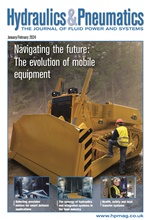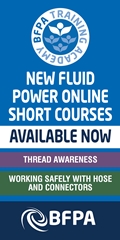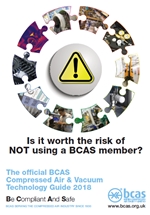- Home » Editorial » Hydraulics
Clean-break coupling makes connection easier
Stäubli has introduced a new range of clean break, flat face, connectors that are claimed to be suitable for all fluids, fully compatible with the well-known SCB range but much easier to connect.
Clean break, flat face connectors are vital in maintaining machine cleanliness and protecting the work environment, factors that are becoming increasingly important in modern production facilities. Avoiding any spillage and protecting circuits from any ingress of air or contaminants on connection and disconnection are essential in ensuring high productivity. But a common problem with most flat faced connectors is that a significant degree of force is needed to make the connection. Stӓubli’s new NCB connector changes all this, requiring only half the normal force to connect.
Significant development
The new NCB connectors are an improvement on the well-known Stäubli SCB connector range; it marks a significant development in connector design and practicality. The new connectors are fully compatible with Stӓubli’s popular SCB clean break connectors and have been designed to be completely interchangeable; they do however offer some useful additional benefits.
Stäubli comments that the connector design it used in the NCB series has resulted in a dramatic reduction in the connection force required, reduced by up to 50 per cent in some cases. The company adds that this is a feature that is particularly useful where one handed operation is needed or making connections in difficult to reach locations or where numerous connections are required each day.
Light and compact
Stäubli reports that the new NCB is also much lighter, typically between 20 and 30 per cent lighter than the SCB equivalent. It is also more compact, a useful feature in the production environment where space is always at a premium. The high quality surface finish and systematic electrolytic polishing in the fluid stream results in a bore that can be cleaned easily and efficiently.
There is a choice of three types of locking system; ball locking is the standard option with screw locking for higher pressures; a further option is a safety locking mechanism which provides visual identification on the outside of the connector showing if it is locked or unlocked. To disconnect the safety locking mechanism the socket sleeve has to be turned to the unlock position which then allows the sleeve to be pulled back to disconnect.
Applications are found on a wide range of production processes especially in the chemical, pharmaceutical, aeronautics, marine and railway sectors, typically used for example on test benches, sampling and liquid cooling of electronics.
Selecting the best connector for any application requires the evaluation of many parameters. Frequently companies rely on the experience of Stäubli engineers who are trained to fully consider all aspects of the application and are skilled in evaluating the combination of requirements. They will provide support and advice right from concept through to final installation and beyond, specifying the most suitable connection solution for any application that will ensure excellent performance, long term reliability and minimum maintenance.
-
Smart Manufacturing & Engineering Week
05 - 06 June, 2024
NEC, Birmingham -
HILLHEAD 2024
25 June, 2024, 9:00 - 27 June, 2024, 16:00
Hillhead Quarry, Buxton, Derbyshire UK










